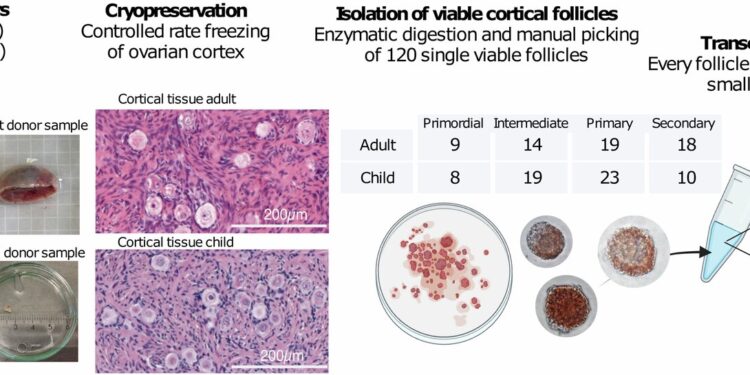Experimental device. Credit: Nature Communications (2024). DOI: 10.1038/s41467-024-51185-0
A recent study published in Nature Communications A study by researchers at the Karolinska Institute offers new insights into the development of ovarian follicles, which are essential for female fertility because they contain oocytes.
The study, led by Pauliina Damdimopoulou, Senior Lecturer and Research Group Leader in the Department of Clinical Sciences, Intervention and Technology, provides a detailed comparison of immature follicles from children and adults. The results reveal significant, previously unknown variations in immature oocytes and identify key markers involved in the early activation of follicle growth.
Ovarian follicles are essential for female fertility. They form during fetal development and constitute a limited reserve of about one million primordial follicles. Each follicle contains an immature oocyte that is arrested in its development and remains dormant until it is activated to develop. The activation and growth of follicles to ovulation is a process that takes about a year in men.
Although full growth to ovulation is not possible until after puberty, early growth stages occur even in children. This study focuses on early arrested follicles and their early growth stages, providing the first comparison between adult and child follicles.
The research team analyzed the transcriptomes of 120 immature follicles from children and adults. They found two main follicle types in both age groups: one with a gene expression profile typical of immature oocytes, and the other with very weak oocyte markers but a predicted role in signaling. This suggests that a subset of follicles may not be focused on maturing their oocytes but could instead play a role in secreting growth factors, potentially promoting the growth of other follicles.
Although transcriptional changes during early follicular growth are broadly similar in children and adults, variations related to extracellular matrix, theca cell, and miRNA profiles were observed. This suggests that immature follicles formed during fetal development undergo changes when girls reach sexual maturity.
The study also found that follicle morphology alone is not enough to reliably classify follicles, highlighting the need for additional markers. Identifying marker genes for follicle subtypes and early growth could help refine methods for assessing fertility in women.
The human ovarian cortex contains two distinct populations of follicles. Credit: Nature Communications (2024). DOI: 10.1038/s41467-024-51185-0
Implications for fertility preservation
Children and women undergoing cancer treatments are at higher risk of infertility because chemotherapy is toxic to follicles. Some of the study samples came from children undergoing fertility preservation, a technique in which a piece of ovary containing immature follicles is removed and cryopreserved before harmful treatments begin.
The authors found that follicles from treated children had increased inflammation. It is unclear how follicle inflammation might affect oocyte quality.
“Cryopreservation of ovarian tissue is a proven method to preserve fertility in adults and is even applied in prepuberty despite unproven efficacy,” says Pauliina Damdimopoulou. “Our results will help refine these techniques and improve outcomes for patients in different age groups.”
This study highlights the importance of understanding the complex biology of ovarian follicles in children and adults in order to develop better fertility preservation strategies and infertility treatments. By identifying key markers of ovarian follicle health, the study paves the way for more effective interventions to protect and preserve fertility.
“Our study provides a better understanding of ovarian follicle heterogeneity and highlights the need for more accurate markers for follicle classification,” Damdimopoulou adds. “This knowledge is crucial for advancing fertility preservation methods and could even impact how we assess fertility in adult women seeking assisted reproduction.”
More information:
Ilmatar Rooda et al, A comprehensive analysis of transcriptomes in ovarian cortical follicles from children and adults reveals interfollicular heterogeneity, Nature Communications (2024). DOI: 10.1038/s41467-024-51185-0
Provided by the Karolinska Institute
Quote:Study provides new insights into ovarian follicle development and previously unknown variations (2024, September 25) retrieved September 25, 2024 from
This document is subject to copyright. Apart from any fair dealing for the purpose of private study or research, no part may be reproduced without written permission. The content is provided for informational purposes only.



